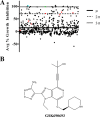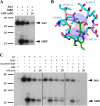A screen for kinase inhibitors identifies antimicrobial imidazopyridine aminofurazans as specific inhibitors of the Listeria monocytogenes PASTA kinase PrkA
- PMID: 28821610
- PMCID: PMC5641865
- DOI: 10.1074/jbc.M117.808600
A screen for kinase inhibitors identifies antimicrobial imidazopyridine aminofurazans as specific inhibitors of the Listeria monocytogenes PASTA kinase PrkA
Abstract
Bacterial signaling systems such as protein kinases and quorum sensing have become increasingly attractive targets for the development of novel antimicrobial agents in a time of rising antibiotic resistance. The family of bacterial
Keywords: Listeria monocytogenes; PASTA Kinase; aminofurazans; antibiotics; bacterial protein kinase; bacterial signal transduction; drug discovery; drug screening; β-lactams.
Conflict of interest statement
The SGC is a registered charity (number 1097737) that receives funds from AbbVie, Bayer Pharma AG, Boehringer Ingelheim, Canada Foundation for Innovation, Eshelman Institute for Innovation, Genome Canada, Innovative Medicines Initiative (EU/EFPIA) ULTRA-DD Grant 115766, Janssen, Merck & Co., Novartis Pharma AG, Ontario Ministry of Economic Development and Innovation, Pfizer, São Paulo Research Foundation-FAPESP, Takeda, and Wellcome Trust Grant 106169/ZZ14/Z. N. W., R. S., and J. D. S. are inventors on U. S. Patent number 9,540,369 for the Use of Kinase Inhibitors to Increase the Susceptibility of Gram-positive Bacteria to β-lactam Antibiotics
Figures





Similar articles
-
Selective pharmacologic inhibition of a PASTA kinase increases Listeria monocytogenes susceptibility to β-lactam antibiotics.Antimicrob Agents Chemother. 2014 Aug;58(8):4486-94. doi: 10.1128/AAC.02396-14. Epub 2014 May 27. Antimicrob Agents Chemother. 2014. PMID: 24867981 Free PMC article.
-
PASTA kinase-dependent control of peptidoglycan synthesis via ReoM is required for cell wall stress responses, cytosolic survival, and virulence in Listeria monocytogenes.PLoS Pathog. 2021 Oct 8;17(10):e1009881. doi: 10.1371/journal.ppat.1009881. eCollection 2021 Oct. PLoS Pathog. 2021. PMID: 34624065 Free PMC article.
-
In Silico Screen and Structural Analysis Identifies Bacterial Kinase Inhibitors which Act with β-Lactams To Inhibit Mycobacterial Growth.Mol Pharm. 2018 Nov 5;15(11):5410-5426. doi: 10.1021/acs.molpharmaceut.8b00905. Epub 2018 Oct 18. Mol Pharm. 2018. PMID: 30285456 Free PMC article.
-
Evaluation of small molecule kinase inhibitors as novel antimicrobial and antibiofilm agents.Chem Biol Drug Des. 2021 Dec;98(6):1038-1064. doi: 10.1111/cbdd.13962. Epub 2021 Oct 4. Chem Biol Drug Des. 2021. PMID: 34581492 Free PMC article. Review.
-
Do Shoot the Messenger: PASTA Kinases as Virulence Determinants and Antibiotic Targets.Trends Microbiol. 2018 Jan;26(1):56-69. doi: 10.1016/j.tim.2017.06.010. Epub 2017 Jul 19. Trends Microbiol. 2018. PMID: 28734616 Free PMC article. Review.
Cited by
-
Antibacterial Activity of Small Molecules Which Eradicate Methicillin-Resistant Staphylococcus aureus Persisters.Front Microbiol. 2022 Feb 1;13:823394. doi: 10.3389/fmicb.2022.823394. eCollection 2022. Front Microbiol. 2022. PMID: 35178043 Free PMC article.
-
The impacts of animal agriculture on One Health-Bacterial zoonosis, antimicrobial resistance, and beyond.One Health. 2024 May 8;18:100748. doi: 10.1016/j.onehlt.2024.100748. eCollection 2024 Jun. One Health. 2024. PMID: 38774301 Free PMC article. Review.
-
Diacetylcurcumin: a novel strategy against Enterococcus faecalis biofilm in root canal disinfection.Future Microbiol. 2024;19(8):647-654. doi: 10.2217/fmb-2023-0235. Epub 2024 Apr 25. Future Microbiol. 2024. PMID: 38661711 Free PMC article.
-
The enterococcal PASTA kinase: A sentinel for cell envelope stress.Mol Oral Microbiol. 2021 Apr;36(2):132-144. doi: 10.1111/omi.12313. Epub 2020 Oct 5. Mol Oral Microbiol. 2021. PMID: 32945615 Free PMC article. Review.
-
An integrative, multi-omics approach towards the prioritization of Klebsiella pneumoniae drug targets.Sci Rep. 2018 Jul 17;8(1):10755. doi: 10.1038/s41598-018-28916-7. Sci Rep. 2018. PMID: 30018343 Free PMC article.
References
-
- Lewis K. (2013) Platforms for antibiotic discovery. Nat. Rev. Drug Discov. 12, 371–387 - PubMed
-
- Frieden T. (2013) Antibiotic resistance threats in the United States, 2013. CDC CS239559-B
-
- O'Neill J. (2014) Antimicrobial resistance: tackling a crisis for the health and wealth of nations. Review on Antimicrobial Resistance, HM Government and the Wellcome Trust.
-
- Spellberg B., Powers J. H., Brass E. P., Miller L. G., and Edwards J. E. (2004) Trends in antimicrobial drug development: implications for the future. Clin. Infect. Dis. 38, 1279–1286 - PubMed
-
- Projan S. J., and Shlaes D. M. (2004) Antibacterial drug discovery: is it all downhill from here? Clin. Microbiol. Infect. 10, 18–22 - PubMed
MeSH terms
Substances
Associated data
- Actions
- Actions
Grants and funding
LinkOut - more resources
Full Text Sources
Other Literature Sources
Medical
Research Materials
Miscellaneous

